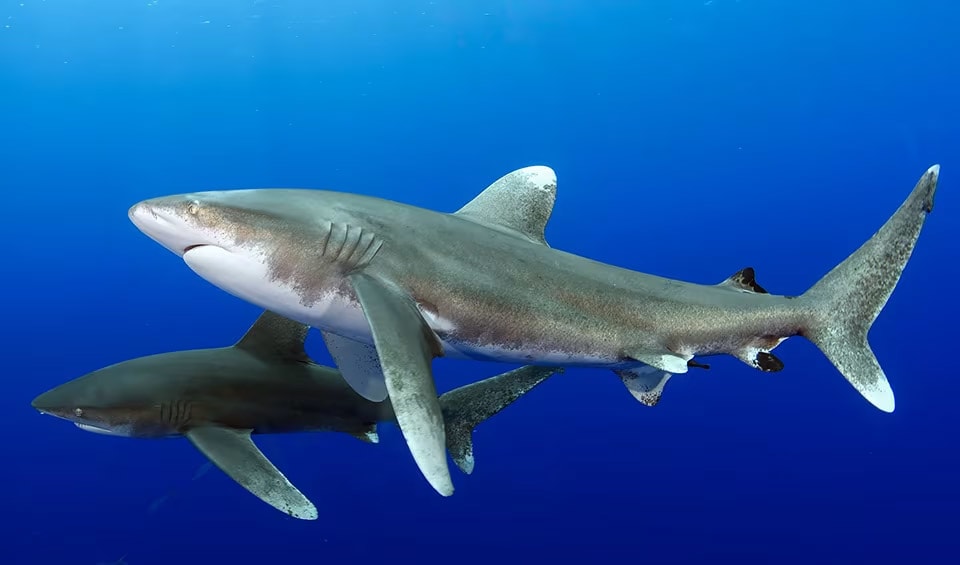Its large, rounded fins featuring distinctive white markings make it an easily recognizable species of large pelagic shark. The white tips of its dorsal, pectoral, and caudal fins provide a stark contrast against its brownish-grey to bluish-grey body, helping to identify the shark from a distance.
These sharks can grow to considerable lengths, with average sizes ranging from 1.8 to 2.5 meters (5.9 to 8.2 feet), and the largest individuals measuring over 3 meters (9.8 feet) and weighing up to 170 kilograms (370 pounds). Their bulky body and broad, paddle-like pectoral fins are designed for sustained, energy-efficient cruising through open waters, allowing them to exploit a vast range that spans both tropical and temperate oceans.
As opportunistic feeders, they have a varied diet that includes cephalopods, bony fish, and occasionally crustaceans. They have also been observed feeding on carrion and the bycatch from fishing vessels. One of the oceanic whitetip’s more noted behaviors is their association with pilot fish, which often accompany the sharks, feeding on parasites and scraps of their host’s meals.
Despite their robust size and formidable appearance, oceanic whitetips have declined significantly in numbers due to overfishing and the demand for their fins, meat, and oil. They are frequently caught as bycatch in longline and gillnet fisheries, which, combined with their slow reproductive rates, makes recovery difficult for their populations. The International Union for Conservation of Nature (IUCN) has listed the oceanic whitetip shark as “Critically Endangered,” with populations decreasing worldwide.
Distribution
 Atlantic Ocean
Atlantic Ocean Indian Ocean
Indian Ocean Pacific Ocean
Pacific Ocean Gulf of Mexico
Gulf of Mexico American Samoa
American Samoa Angola
Angola Anguilla
Anguilla Antigua & Barbuda
Antigua & Barbuda Argentina
Argentina Aruba
Aruba Australia
Australia Bahamas
Bahamas Bangladesh
Bangladesh Barbados
Barbados Belize
Belize Benin
Benin Bermuda
Bermuda Bonaire
Bonaire Brazil
Brazil British Indian T.
British Indian T. British Virgin Is.
British Virgin Is. Brunei
Brunei Cambodia
Cambodia Cameroon
Cameroon Cape Verde
Cape Verde Cayman Islands
Cayman Islands China
China Christmas Island
Christmas Island Cocos Is. (Keeling)
Cocos Is. (Keeling) Colombia
Colombia Comoros
Comoros Cook Islands
Cook Islands Costa Rica
Costa Rica Cuba
Cuba Curaçao
Curaçao Côte D’ivoire
Côte D’ivoire DR Congo (Kinshasa)
DR Congo (Kinshasa) Djibouti
Djibouti Dominica
Dominica Dominican Republic
Dominican Republic Ecuador
Ecuador Egypt
Egypt El Salvador
El Salvador Equatorial Guinea
Equatorial Guinea Eritrea
Eritrea Fiji
Fiji France
France French Guiana
French Guiana French Polynesia
French Polynesia Gabon
Gabon Gambia
Gambia Ghana
Ghana Grenada
Grenada Guadeloupe
Guadeloupe Guam
Guam Guatemala
Guatemala Guinea-Bissau
Guinea-Bissau Guinea
Guinea Guyana
Guyana Haiti
Haiti Honduras
Honduras Hong Kong
Hong Kong India
India Indonesia
Indonesia Israel
Israel Jamaica
Jamaica Japan
Japan Kenya
Kenya Liberia
Liberia Macao
Macao Madagascar
Madagascar Malaysia
Malaysia Maldives
Maldives Marshall Islands
Marshall Islands Martinique
Martinique Mauritania
Mauritania Mauritius
Mauritius Mexico
Mexico Montserrat
Montserrat Morocco
Morocco Myanmar
Myanmar Nauru
Nauru New Caledonia
New Caledonia New Zealand
New Zealand Nicaragua
Nicaragua Niue
Niue Nort. Mariana Is.
Nort. Mariana Is. Oman
Oman Pakistan
Pakistan Palau
Palau Panama
Panama Papua New Guinea
Papua New Guinea Peru
Peru Philippines
Philippines Pitcairn
Pitcairn Portugal
Portugal Puerto Rico
Puerto Rico Réunion
Réunion Saint Barthélemy
Saint Barthélemy Saint Helena
Saint Helena Saint Lucia
Saint Lucia Saint Martin
Saint Martin Saint Vincent
Saint Vincent Samoa
Samoa Saudi Arabia
Saudi Arabia Senegal
Senegal Seychelles
Seychelles Sierra Leone
Sierra Leone Singapore
Singapore Sint Maarten
Sint Maarten Slovenia
Slovenia Solomon Islands
Solomon Islands Somalia
Somalia South Africa
South Africa Spain
Spain Sri Lanka
Sri Lanka St. Kitts & Nevis
St. Kitts & Nevis Sudan
Sudan Suriname
Suriname São Tomé & Príncipe
São Tomé & Príncipe Taiwan
Taiwan Tanzania
Tanzania Thailand
Thailand Togo
Togo Tokelau
Tokelau Tonga
Tonga Trinidad & Tobago
Trinidad & Tobago Turks & Caicos
Turks & Caicos Tuvalu
Tuvalu US Virgin Islands
US Virgin Islands US Minor Is.
US Minor Is. United States
United States Uruguay
Uruguay Vanuatu
Vanuatu Venezuela
Venezuela Vietnam
Vietnam Yemen
YemenAnything we've missed?
Help us improve this page by suggesting edits. Glory never dies!
Suggest an editGet to know me
Terrestrial / Aquatic
Altricial / Precocial
Polygamous / Monogamous
Dimorphic (size) / Monomorphic
Active: Diurnal / Nocturnal
Social behavior: Solitary / Pack / Herd
Diet: Carnivore / Herbivore / Omnivore / Piscivorous / Insectivore
Migratory: Yes / No
Domesticated: Yes / No
Dangerous: Yes / No




